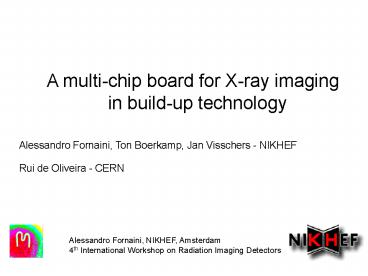A multichip board for Xray imaging - PowerPoint PPT Presentation
Title:
A multichip board for Xray imaging
Description:
A multi-chip board for X-ray imaging. in build-up technology ... CMOS chip size: max. 25 x 25 mm2 due to reticle size. of wafer stepper ... – PowerPoint PPT presentation
Number of Views:44
Avg rating:3.0/5.0
Title: A multichip board for Xray imaging
1
A multi-chip board for X-ray imaging
in build-up technology
Alessandro Fornaini, Ton Boerkamp, Jan Visschers
- NIKHEF Rui de Oliveira - CERN
Alessandro Fornaini, NIKHEF, Amsterdam 4th
International Workshop on Radiation Imaging
Detectors
2
Hybrid Pixel detectors
Semiconductor sensor High purity, single crystal
(Si, GaAs, ..)
Pixel diode
Xray
55 mm
300 - 600 mm
Bumps
Single pixel Read Out cell
CMOS electronics
Single photon counting
1
3
Hybrid Pixel detectors (2)
Problem size limitations!
Sensor size not a problem (15 cm diam. high
res. Si)
CMOS chip size max. 25 x 25 mm2 due to reticle
size of wafer stepper (Medipix2 0.25mm
technology, area 14 x 16 mm2)
- Non-standard production techniques (stitching)
to - circumvent this but
- Expensive
- Yield inversely proportional to chip area! (due
to - density of point defects and contaminations)
2
4
Our solution tiled array of chips
Medipix2 setup
Si sensor, 28 x 56 mm2 Bump bonded
Chipboard with 2 X 4 tiled ASIC chips
Medipix2 512 x 1024 Pixels
Bias
PC with Medisoft4 and NI DIO card
Muros2 interface
3
5
Other tiled arrays
4
6
Medipix2 setup
8 Medipix2 ASIC chips, 14 X 16 mm2
1 High Res. Si sensor, 28 X 56 mm2
Chipboard in Chip-on-Board technology
Interface card to PCI DIO card (Muros2)
Sensor bias voltage supply (commercial)
PC with HS DIO board (commercial)
7
Medipix2 Interconnectivity
LVDS (Low Voltage Differential Signal) Reduce
noise generation, noise sensitivity,
interconnectivity Better performance for large
arrays
Serial Daisy Chain Token passing protocol
(LVDS) 160 Mhz CLK 1 Mbit data per chip 160 Mhz ?
160/Ntot frames/sec
Medipix2 chip N
Medipix2 chip N1
DATA
CLK
ENABLE
Common single-ended CMOS bus shutter, mode
control, reset, polarity and analog signals (test
input, DAC output)
5
8
Routing
Top layer metal 1, 2 Vdd, Gnd and LVDS token
ring 160 Mhz!
Chip-on-Board (COB) technology
Pitch of wirebonds 120 mm, NO
FANOUT Interconnection High Density Interconnect
(HDI) technology
6
9
Interconnections
High Density Interconnect (HDI) Build-up
technology
From IPC/JPCA-2315 Design Guide for High Density
Interconnects (HDI)
Staggered Micro-Vias
(photolitographic etching)
7
10
Multilayer board
Beryllium Foil
Vbias
lt 6 mm
Box
Pixel Sensor
clock
VDD-LVDS
Medipix 2
token
VDD
Controls
VDDA
data
GND
Gnd Gnd busX busY busX VDD VDDA VDDL GND
Peltier Cooler
Capacitor
FET switch
9 layers (4 metal, 5 build-up)
8
11
Test Pulse
FET switch
DAC 1
to input analog test Medipix2 chip
DAC 2
FPGA
Medipix2 chipboard
Muros2
9
12
Multilayer board (2)
1.6 mm total thickness, area 53 x 110 mm2
10
13
Vias and Tracks dimensions
1840 micro-vias 366 through vias 80 SMD
capacitors 8 CMOS FETs
11
14
Chipboard layout
Chip bond pads
Power bars
Decoupling capacitors
LVDS pairs
FET switch, capacitors
Test points
1 cm
12
15
Chipboard layout
Vbias connector
1 cm
SCSI-5 connector
2 x 4 Medipix2 chip array
13
16
and the actual chipboard
Power bars
Vbias connector
SCSI-5 connector
2 x 4 MPix2 chip array
LVDS pairs
1 cm
14
17
1 cm
Power bars
LVDS pairs
15
18
1 cm
16
19
Status
16 prototypes boards produced at
CERN Connectivity tests performed on 3
boards NO DESIGN ERRORS! But production
defects (1 short, 2 connections - easily
solvable)
17
20
Conclusion
A 2 x 2 sensor will be mounted and tested. We
expect to have a 2 x 4 multichipboard running in
6 months
18
21
(No Transcript)
22
Tiled array chips boundary
Chip separation 220 mm (4 pixels) Sensor pixels
at boundary 55 x 55 mm2 ? 55 x 165 mm2
165 mm
220 mm
55 mm
NO DEAD AREA but non uniformity (resolution,
overflow)

